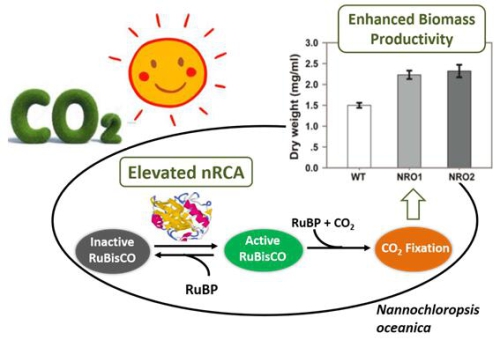
Industrial oil-producing microalgae can convert carbon dioxide and light energy into oil and fat on a large scale through photosynthesis. As a potential solution for clean energy production and high CO2 value, it has received extensive attention at home and abroad. In response to the key issue of how to increase the carbon sequestration capacity of industrial oil-producing microalgae, the Institute of Bioenergy and Bioprocess Research of the Chinese Academy of Sciences demonstrated a method for regulating RuBisCO (ribulose-1,5-bisphosphate carboxylase/oxygenation). Enzyme-enhanced enzymes are used to enhance cell carbon sequestration activity, thereby greatly increasing the strategy of microalgae biomass and oil yield. This work was published online at Algal Research. The dramatic increase in CO2 fixation and conversion efficiency of industrial oil-producing microalgae is one of the bottlenecks in the economic viability of the microalgae energy industry, and it is also a focus of attention in the academic and industrial communities. In the mode of single-cell photosynthetic organisms such as cyanobacteria and Chlamydomonas reinhardtii, the capacity for carbon fixation has been enhanced. The pre-research community mainly improved RuBisCO by modifying the photosynthesis carbon sequestration enzyme RuBisCO itself, or by regulating carbonic anhydrase. CO2 concentration. However, in the production of oil-producing microalgae, there are no successful precedents for molecular breeding of carbon-fixing capacity.
Nannochloropsis is an industrial microalgae that can be cultivated in large quantities outdoors using seawater or freshwater. It has the advantages of high growth rate, strong carbon dioxide tolerance, strong accumulation of oils and fats, and high value of unsaturated fatty acids. Therefore, it has become an industry. One of the major model research systems for molecular breeding of microalgae has also become the preferred choice for many microalgal scale demonstration projects at home and abroad.
Based on previous CO2 stress-induced transcriptomes of Nannochloropsis, Wei Li, Xu Jian, et al., of the Single Cell Center Functional Genome Team of Qingdao Energy Research Institute, discovered a nuclear-encoded RuBisCO activase (nRCA) encoded by the nuclear genome of the research team. Significant up-regulation at a specific time point indicates that it plays an important role in cell-fixed CO2 mechanisms. RuBisCO activase can affect the spatial configuration of RuBioCO and prevent the latter from binding to its inhibitor (phosphate sugar) so that the latter remains active; Rubisco activase also has ATP hydrolase activity and can regulate ATP/ADP ratio changes. This affects the energy balance in the chloroplast.
The researchers found that at an air-level CO2 concentration, the growth rate of the Nannochloropsis alga strain overexpressing the endogenous nRCA increased by 32%, the biomass accumulation rate increased by 46%, and the oil yield increased compared with the wild-type. 41%. While photosynthetic and autotrophic conditions significantly increased biomass and fat yields, the composition of fatty acids in total fats did not change substantially, thus achieving a significant increase in the strength of oil production under the precondition of ensuring oil quality. According to the open literature, this is the first report on the improvement of biomass and oil yields through the transformation of photosynthetic carbon fixation in industrial oil-producing microalgae.
RuBisCO is a polymer composed of two subunits, big and small, with a molecular weight of ~500 kD. It is difficult to regulate and modify this highly sophisticated large-scale molecular machine. Recent studies have shown that in industrial oil-producing microalgae, rational regulation and design of the “functional chaperone†of RuBisCO represented by nRCA, rather than merely aiming at RuBisCO itself, may result in the fixation of CO2, biomass synthesis, or even the production efficiency of the target product. Raise the effect of "a couple of things". It is expected that this method will be one of the effective strategies for the design and modification of microalgal photosynthetic carbon fixation systems.
In microalgae cells, the conversion process from CO2 to high-energy or high-value target molecules can be divided into three key links: carbon capture, carbon allocation, and carbon storage. In the "carbon capture" link, the above strategies were used to transform the team's previous two-phase mechanism research and metabolic engineering. The researchers designed and constructed "high-efficiency carbon sequestration, precise synthesis, and scale-based cultivation in an all-round, multi-site manner." "The "Super Industrial Microalgae Cell Factory".
The research was supported by the key deployment project of the "Artificial Biotransformation of CO2" of the Chinese Academy of Sciences and the National Natural Science Outstanding Youth Fund.
Aluminum Alloy Plate
Xiaoxian RuiYi Commercial Trade Co.,Limited , https://www.ryaluplate.com